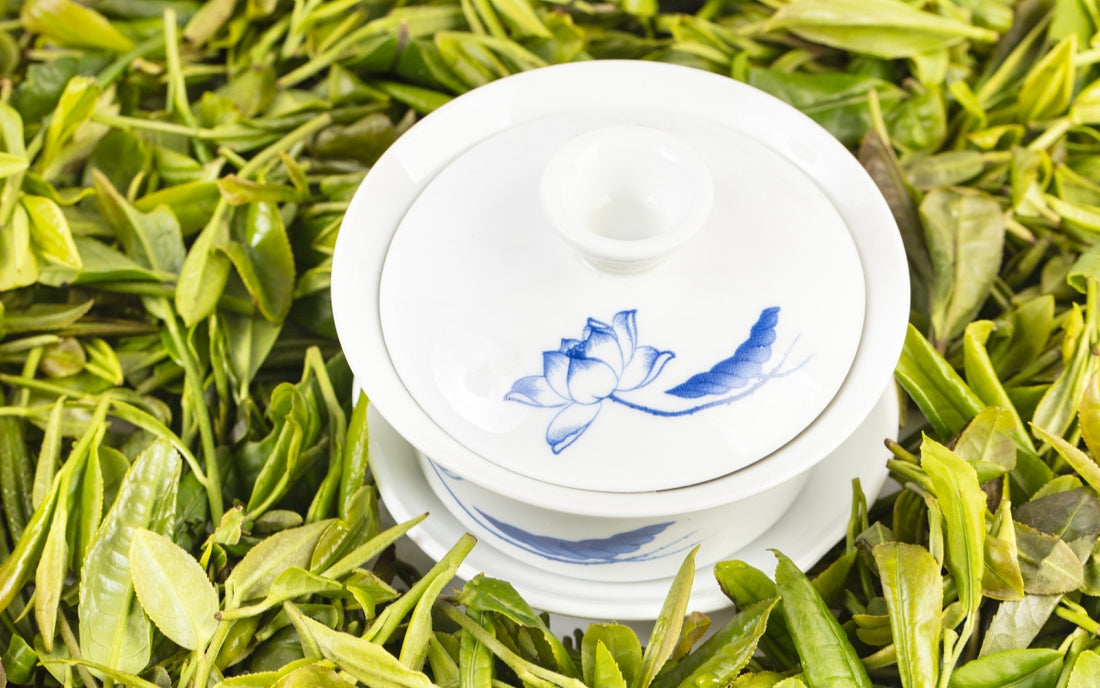
Gaiwan Pairs with Different Teas
ZenBrew Tea StudioA Gaiwan, a tea vessel with a longstanding history and deep cultural roots, is far more than just a simple utensil. It is like an old friend who truly understands tea, adept at capturing and revealing the spirit of each brew. With its elegant yet minimal design and a lid that can be opened or tilted to control steeping, a Gaiwan allows precise management of water temperature and infusion time, ensuring the individual character of any tea is presented at its best.
In this article, ZenBrew Tea Studio will guide you on how to pair different types of tea with a gaiwan to achieve the best drinking experience. This is an advanced guide to using a gaiwan. If you are new to gaiwan brewing, we recommend starting with our beginner-friendly guide - How to Use and Maintain a Gaiwan.
Green Tea: A Refined Encounter of Fragrance and Freshness

For green tea, the transparent or semi-transparent material of a Gaiwan lets tea lovers witness the graceful “dance” of tea leaves unfurling in hot water, while preserving the tea’s fresh taste and delicate aroma.
Brewing Tips
• Water Temperature: Around 80–85°C (176–185°F) to maintain the tea’s refreshing character.
• Infusion Time: 10–20 seconds for the first infusion, then adjust to taste.
Tasting Experience
Whether brewing Longjing or Biluochun, you’ll see a clear green liquor and enjoy a fresh, sweet aroma—evoking a stroll through tranquil tea gardens in southern China.
White Tea: Subtle Floral Notes and a Gentle Sweetness

White tea, crafted through minimal processing and natural aging, carries delicate floral scents and a soft, sweet aftertaste. A Gaiwan is ideal for preserving its subtle fragrance, while also letting aged white teas display a richer, mellower body.
Brewing Tips
• Water Temperature: Around 85–90°C (185–194°F), balancing both aroma release and avoiding over-steeping.
• Infusion Time: Start with about 20–30 seconds, then adjust each infusion as you go.
Tasting Experience
Sipping White Peony or Shoumei reveals a sweetness imbued with years of natural aging—like journeying through time, tasting the quiet depth of history.
Oolong Tea: A Dance of Floral, Fruity, and Roasted Notes

Oolong teas, especially carefully roasted varieties, exhibit complex aromas and flavors. By allowing flexible control over temperature and steeping, a Gaiwan captures Oolong’s transformation from light and floral to rich and roasted.
Brewing Tips
• Water Temperature: 90–95°C (194–203°F). Some heavily roasted Oolongs can be brewed with boiling water.
• Infusion Time: Typically short, frequent infusions (10–20 seconds each) to experience the evolving taste profiles.
Tasting Experience
Whether steeping Tieguanyin or Da Hong Pao, expect layers of floral, fruity, or roasted notes. It feels like a journey through Wuyi Mountain’s mist-laden valleys, breathing in nature’s crisp freshness.
Black Tea: Smooth Sweetness in a Warm, Radiant Cup

Black tea is loved for its bright red liquor and rich, sweet taste. A Gaiwan preserves the warmth of the infusion while allowing the tea’s aroma to disperse freely, unhindered by the vessel itself.
Brewing Tips
• Water Temperature: 95–100°C (203–212°F) so the full sweetness and aroma emerge.
• Infusion Time: About 20–30 seconds for the first infusion, adjusting according to personal preference.
Tasting Experience
In brewing Keemun Black Tea or Lapsang Souchong, you’ll notice a refined sweetness and smooth texture—like enjoying a serene afternoon tea with a touch of elegance and poise.
Pu-Erh Tea: Echoes of Time in Each Sip

Pu-erh tea (both raw and ripe) captivates tea enthusiasts with its aging potential and unique character. A Gaiwan offers precise temperature control, ensuring the tea’s distinctive qualities—whether the brisk notes of raw Pu-erh or the mellow earthy notes of ripe Pu-erh—are showcased to the fullest.
Brewing Tips
• Water Temperature: 95–100°C. For older raw Pu-erh, slightly lower temperatures can highlight its aroma.
• Infusion Time: Approximately 10–20 seconds, then multiple short steeps to savor the changing flavors.
Tasting Experience
Raw Pu-erh reveals a potent, lingering sweetness and sometimes floral fragrance, while ripe Pu-erh is velvety, earthy, and soothing—like walking through ancient Yunnan tea mountains rich in history.
Floral Teas: A Sweet Bouquet of Fragrance and Softness

Beloved for their distinctive floral aromas and sweet flavors, floral teas thrive in a Gaiwan, which helps retain their fragrance and allows the blossoms to unfold before your eyes.
Brewing Tips
• Water Temperature: 80–90°C (176–194°F), varying slightly depending on the specific flowers.
• Infusion Time: 15–20 seconds for the first infusion to avoid overpowering the floral scent or creating bitterness.
Tasting Experience
Jasmine or rose tea becomes all the more aromatic and sweet when steeped in a Gaiwan, as if relaxing in a sea of flowers, embraced by nature’s gentle gifts.
A Special Mention: Xiaoqinggan and Other Citrus-Infused Teas

Beyond the above tea types, Gaiwans are also splendid for brewing Xiaoqinggan (small mandarin oranges stuffed with Pu’er), which uniquely combines bright citrus notes with aged tea fragrance.
Brewing Tips
• Water Temperature: Around 95–100°C.
• Infusion Time: Short, frequent steeps (10–20 seconds each) to savor the gradual merging of citrus peel and tea leaves.
Tasting Experience
Watching the citrus peel soften and release its aroma into the Pu’er feels like wandering through a citrus grove, reveling in fresh fruitiness layered with deep tea undertones.
Additional Tips on Materials and Usage



• Vessel Materials: Porcelain Gaiwans excel at heat retention and preserving tea aroma, suitable for most tea types. Glass versions let you enjoy the visual beauty of unfurling leaves but lose heat more quickly. Purple clay (Zisha) Gaiwans are less common than teapots, yet still have a distinctive charm for certain fermented or aged teas.
ZenBrew Tea Studio has visited China’s renowned ceramic capitals, such as Jingdezhen, Dehua, and Yixing, to curate a selection of gaiwans that embody both cultural heritage and artistic beauty for tea enthusiasts. Click here to explore our collection.
• Temperature Control: Mastering water temperature and infusion time is key. Beginners might start with slightly cooler water or fewer leaves to avoid overly strong brews or burns.

• The Three-Finger Grip: Pinch the sides of the bowl with your thumb and middle finger, resting the index finger lightly on the lid. Tilt gently when pouring to control the flow and prevent scalding.
The Elegant World of Gaiwan
Thanks to its ability to preserve the original taste of tea and facilitate precision in brewing, the Gaiwan has become a go-to piece of teaware for many tea enthusiasts. It lets us focus on the tea’s color, aroma, and flavor, while highlighting the aesthetics of utensil and brew in a single glance.
In exploring different teas with a Gaiwan—whether you’re a newcomer to tea or a seasoned connoisseur—you’ll discover not only the changing flavors in your cup but also the serenity and elegance within the act of brewing itself. A Gaiwan is more than just a tool on the tea table; it’s a reflection of a lifestyle rooted in gratitude for nature’s bounty and a desire for a gracious, satisfying life.
If you wish to experience the charm of the gaiwan, we offer you a window to step through and immerse yourself in the elegant world of Gaiwan.
